The COVID-19 Pandemic’s Impact on Cloud Revenue Is a Mixed Bag
Yes, more organizations are turning to the cloud to stay online, but many businesses are also closing for good.
July 14, 2020

This year and next will be a mix bag for cloud service providers businesswise, as the IT world grapples with the COVID-19 pandemic’s impact.
There’s an influx of demand, as organizations adapt to remote work, education, entertainment, and virtually everything else. At the same time, many small and mid-size businesses have been shutting down, either temporarily or permanently, dragging down cloud revenue.
That’s according to analysts at Omdia, whose latest projection for 2020 Software-as-a-Service (SaaS) market revenue is 4 to 5 percent higher than previously expected. They expect the market to grow by 2 to 3 percent in 2021.
Omdia has lowered its previous revenue projection for the IT-infrastructure portion of the cloud market, which includes IaaS, PaaS, and CaaS, by 2 to 3 percent. That market is expected to gain 1 or 2 percent next year.
In addition to the effects of COVID-19, the forecast update also reflects actual 2019 results (as opposed to projections), new and updated cloud services, and data center footprint expansions.
Here’s the current cloud services revenue forecast, including SaaS and IT infrastructure services, as reported by the Omdia Cloud & Colocation Services for IT Infrastructure & Applications Market Tracker:

off premise cloud services 2020 omdia
Devan Adams, principal analyst, Omdia:
“On one hand, data center operators are experiencing massive surges in consumer usage of compute resources due to school closures, social distancing, and government work-at-home mandates. This is making it increasingly imperative to provide a reliable, scalable and secure cloud. The new rules for society have created new norms, resulting in increased demand for e-learning, remote working, binge television watching and other at-home activities. On the other hand, IT infrastructure services—i.e., IaaS, CaaS, PaaS—are experiencing equally negative effects as many small-and-medium businesses (SMBs) either temporarily shut down or prepare to close their doors permanently as they are unable to remain financially viable.”
In a research note, Adams also noted the recent expansion of edge computing offerings by some of the largest cloud providers, who are responding to the push by businesses to lower application latency by placing computing infrastructure closer to end users:
In March 2020, Microsoft introduced Azure Edge Zones and Azure Private Edge Zones to provide consistent Azure services and application platform and management at the edge. The Zones are currently available for preview in North America as part of Microsoft’s early adopter program with AT&T and are expected to expand to more carriers.
Also in March, Google Cloud partnered with AT&T to release several 5G edge computing solutions based on AT&T’s network and Google Cloud. The offerings delivered on AT&T’s network will use Google Cloud’s capabilities like Kubernetes, artificial intelligence, machine learning and data and analytics; the solutions will be accessible globally.
This May, IBM announced edge services designed for enterprises and telecommunications providers. IBM's edge services run on Red Hat OpenShift, which is Kubernetes-based, and can be applied across different multi-clouds and edge environments; the new solutions included IBM Edge Application Manager, IBM Telco Network Cloud Manager, Edge-enabled applications and IBM edge-focused ecosystems (IBM Edge Ecosystem and IBM Telco Network Cloud Ecosystem).
Read more about:
OmdiaAbout the Author(s)
You May Also Like



.jpg?width=700&auto=webp&quality=80&disable=upscale)



